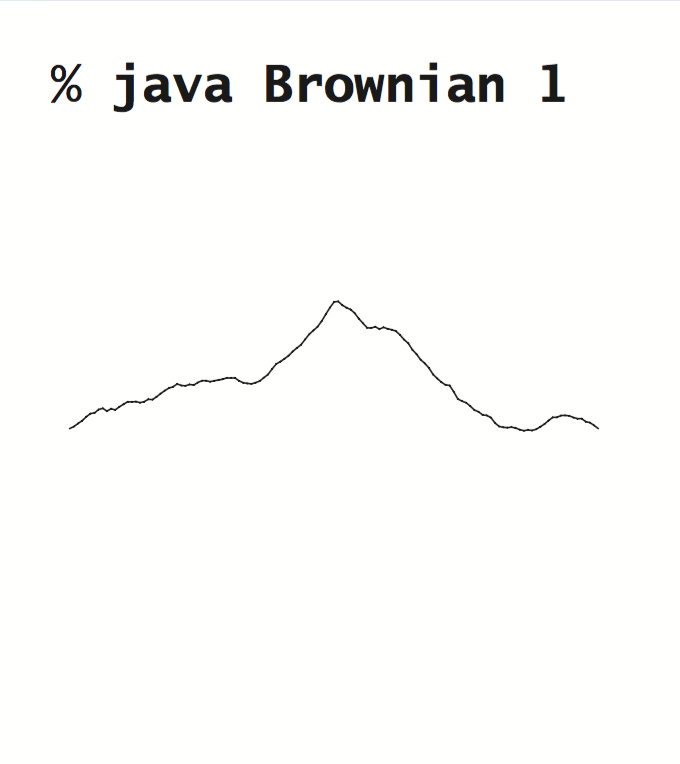2.3 Recursion
The idea of calling one function from another immediately suggests the possibility of a function calling itself. The function-call mechanism in Java supports this possibility, which is known as recursion. Recursion is a powerful general-purpose programming technique, and is the key to numerous critically important computational applications, ranging from combinatorial search and sorting methods methods that provide basic support for information processing (Chapter 4) to the Fast Fourier Transform for signal processing (Chapter 9).
To understand how a recursive static method works, you can proceed as if the system were to create an independent copy of the code for each call (and destroy it on return).
Your first recursive program.
The HelloWorld for recursion is to implement the factorial function, which is defined for positive integers N by the equationN! = N × (N-1) × (N-2) × ... × 2 × 1In other words, N! is the product of the positive integers less than or equal to N. Now, N! is easy to compute with a for loop, but an even easier method in Factorial.java is to use the following recursive function:
This static method calls itself. The implementation produces the desired effect: it corresponds to rewriting the definition as
public static int factorial(int N) { if (N == 1) return 1; return N * factorial(N-1); }
N! = N × (N-1)! = N × ((N-1) × (N-2) × ... × 2 × 1)This equation holds for N > 1; for N = 1, factorial directly computes 1! = 1. To compute factorial(5), it multiplies 5 by factorial(4); to compute factorial(4), it multiplies 4 by factorial(3); and so forth. This process is repeated until factorial(1), which directly returns the value 1. We can trace this computation in precisely the same way that we trace any sequence of function calls. Since we treat all of the calls as being independent copies of the code, the fact that they are recursive is immaterial.
Our factorial() implementation exhibits the two main components that are required for every recursive function. The base case returns a value without making any subsequent recursive calls. It does this for one or more special input values for which the function can be evaluated without recursion. For factorial(), the base case is N = 1. The reduction step is the central part of a recursive function. It relates the function at one (or more) inputs to the function evaluated at one (or more) other inputs. For factorial(), the reduction step is N * factorial(N-1). All recursive functions must have these two components. Furthermore, the sequence of parameter values must converge to the base case. For factorial(), the value of N decreases by one for each call, so the sequence of parameter values converges to the base case N = 1.
The factorial() implementation itself is not particularly useful in practice because N! grows so quickly that the multiplication will overflow and produce incorrect answers for N > 13. But the same technique is effective for computing all sorts of functions. For example, the recursive function
is a simple method in Harmonic.java for computing the Harmonic numbers that is effective when N is small.
public static double H(int N) { if (N == 1) return 1.0; return H(N-1) + 1.0/N; }
H(N) = 1/1 + 1/2 + 1/3 + ... + 1/N = H(N-1) + 1/NRecursive programs like these are just loops in disguise, but recursion can help us better understand a computation.
Mathematical induction.
Recursive programming is directly related to mathematical induction, a technique for proving facts about discrete functions. Proving that a statement involving an integer N is true for infinitely many values of N by mathematical induction involves two steps. Thebase case is to prove the statement true for some specific value or values of N (usually 0 or 1). The induction step is the central part of the proof. For example, we typically assume that a statement is true for all positive integers less than N, then use that fact to prove it true for N. This proof suffices to show that the statement is true for all N: we can start at the base case, and use our proof to establish that the statement is true for each larger value of N, one by one.Everyone's first induction proof is to demonstrate that the sum of the positive integers less than or equal to N is given by the formula N(N+1)/2. That is, we wish to prove that the following equation is valid for all N > 0:
1 + 2 + 3 + ... + (N-1) + N = N(N+1)/2The equation is certainly true for N = 1 (base case). If we assume it to be true for all integers less than N then, in particular, it is true for N - 1, so
1 + 2 + 3 + ... + (N-1) = (N-1)N/2and we can add N to both sides of this equation, simplify the right hand side, and check that and check that it equals the desired result (induction step).
Euclid's algorithm.
The greatest common divisor (gcd) of two positive integers is the largest integer that divides evenly into both of them. For example, the greatest common divisor of 102 and 68 is 34 since both 102 and 68 are multiples of 34, but no integer larger than 34 divides evenly into 102 and 68. You may recall learning about the greatest common divisor when you learned to reduce fractions. For example, we can simplify 68/102 to 2/3 by dividing both numerator and denominator by 34, their gcd. Finding the gcd of huge numbers is an important problem that arises in many commercial applications, including the RSA cryptosystem.We can efficiently compute the gcd using the following property, which holds for positive integers p and q:
If p > q, the gcd of p and q is the same as the gcd of q and p % q.
The static method gcd() in Euclid.java is a compact recursive function whose reduction step is based on this property.
The base case is when q is 0, with gcd(p, 0) = p. To see that the reduction step converges to the base case, observe that the second input strictly decreases in each recursive call since p % q < q. If p ≤ q the first recursive call switches the arguments.
public static int gcd(int p, int q) { if (q == 0) return p; return gcd(q, p % q); }
This recursive solution to the problem of computing the greatest common divisor is known as Euclid's algorithm and is one of the oldest known algorithms - it is over 2000 years old.
Towers of Hanoi.
No discussion of recursion would be complete without the ancient towers of Hanoi problem. We have three poles and n discs that fit onto the poles. The discs differ in size and are initially arranged on one of the poles, in order from largest (disc n) at the bottom to smallest (disc 1) at the top. The task is to move the stack of discs to another pole, while obeying the following rules:- move only one disc at a time
- never place a disc on a smaller one
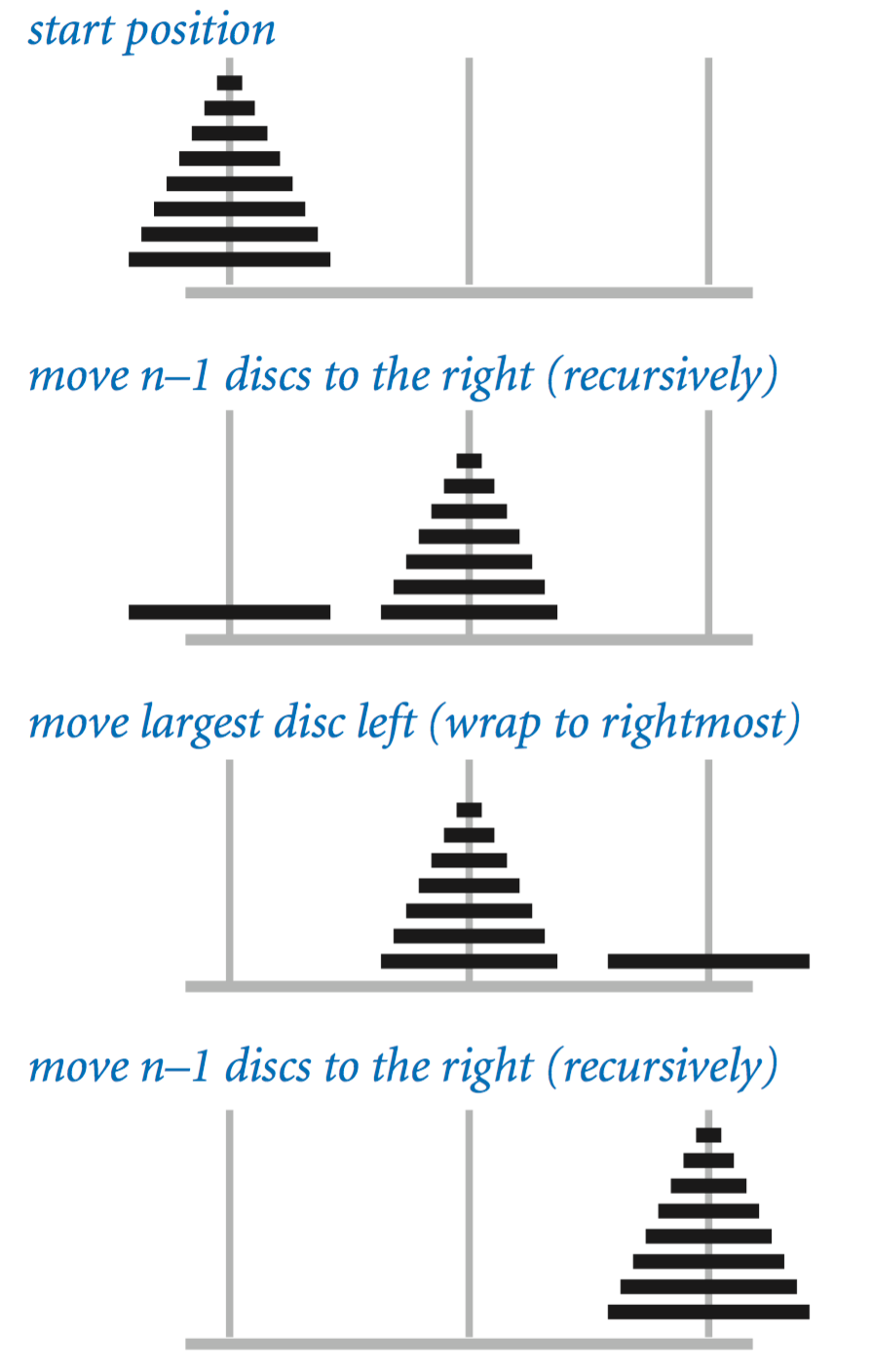 |  |
To solve the problem, our goal is to issue a sequence of instructions for moving the discs. We assume that the poles are arranged in a row, and that each instruction to move a disc specifies its number and whether to move it left or right. If a disc is on the left pole, an instruction to move left means to wrap to the right pole; if a disc is on the right pole, an instruction to move right means to wrap to the left pole. When the discs are all on one pole, there are two possible moves (move the smallest disc left or right); otherwise there are three possible moves (move the smallest disc left or right, or make the one legal move involving the other two poles). Choosing among these possibilities on each move to achieve the goal is a challenge that requires a plan.
Recursion provides just the plan that we need, based on the following idea: First we move the top n - 1 discs to an empty pole, then we move the largest disc to the other empty pole, then complete the job by moving the n - 1 discs onto the largest disc. TowersOfHanoi.java is a direct implementation of this strategy. It reads in a command-line argument n and prints out the solution to the Towers of Hanoi problem on n discs. The recursive method moves() prints the sequence of moves to move the stack of discs to the left (if the argument left is true) or to the right (if leftis false). It does so exactly according to the plan just described.
If you study the function call trace, you are likely to immediately notice several patterns, including
- every other move involves the smallest disc
- the smallest disc always moves in the same direction
- the number of moves is 2n - 1
Gray code.
The towers of Hanoi problem is intimately related to basic algorithms for manipulating numbers and discrete objects. As an example, we consider Gray codes, which have numerous scientific and commercial applications. The playwright Samuel Beckett, perhaps best known for Waiting for Godot, wrote a play called Quad that had the following property: Starting with an empty stage, characters enter and exit one at a time, but each subset of characters on the stage appears exactly once. The play had four characters and there are 2^4 = 16 different subsets of four elements; hence the title. How did Beckett generate the stage directions for this play? How would we do it for 5 actors, or more?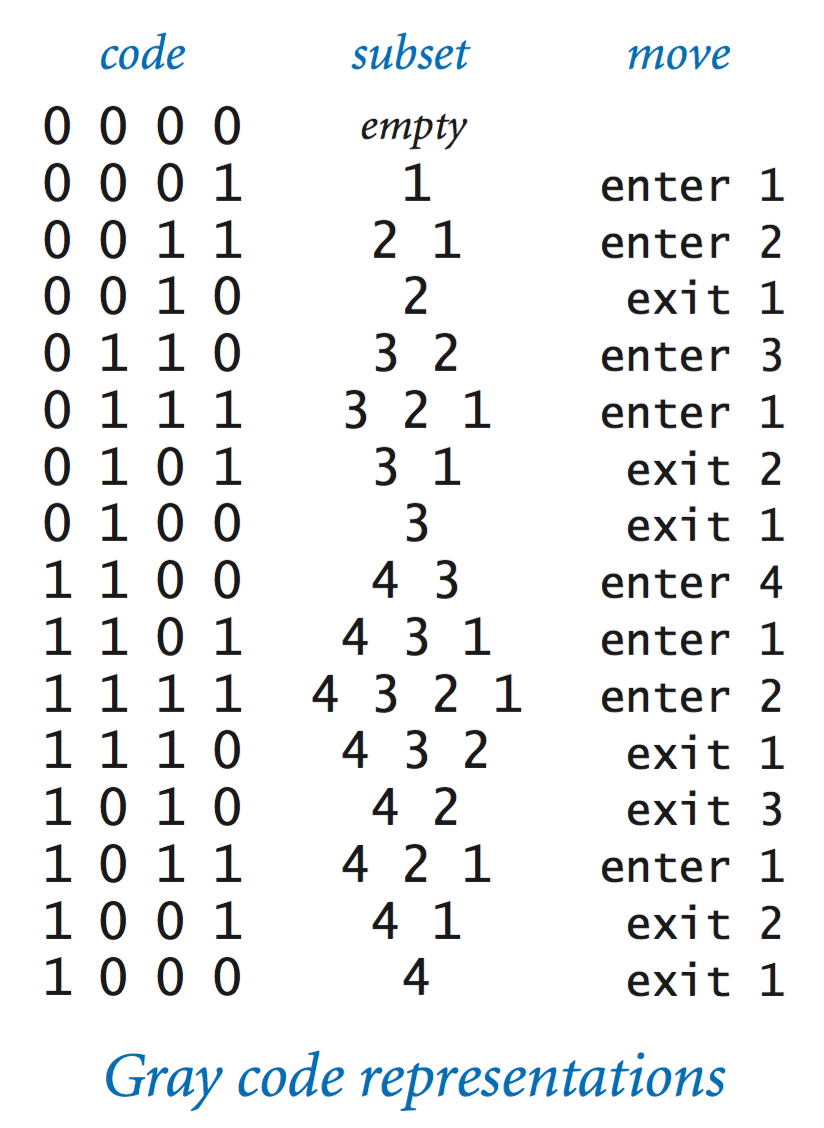 | 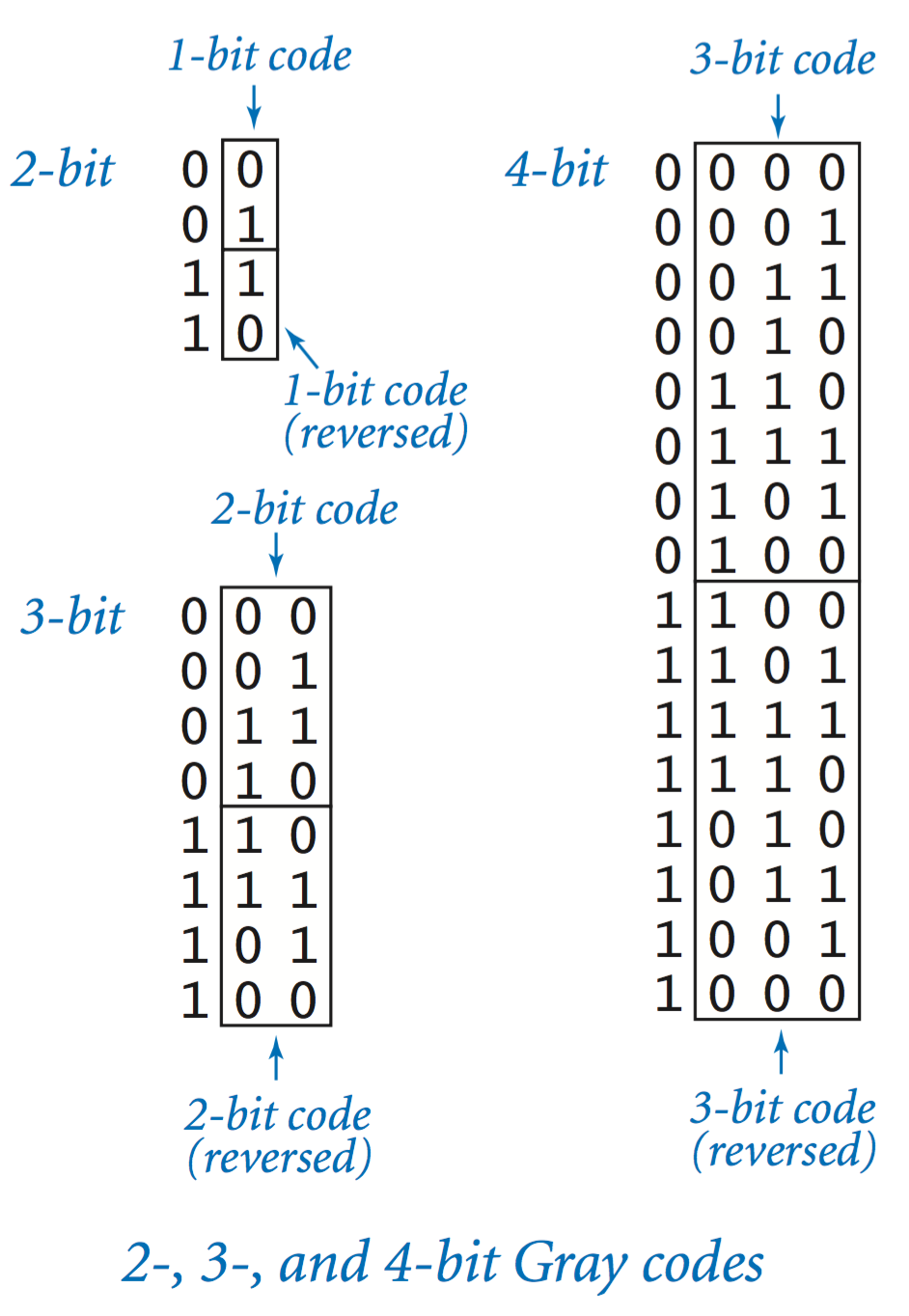 |
An n-bit Gray code is a list of the 2^n different n-bit binary numbers such that each entry in the list differs in precisely one bit from its predecessor. Gray codes directly apply to Beckett's problem because we can interpret each bit as denoting whether the integer corresponding to its bit position is in the subset. Changing the value of a bit from 0 to 1 corresponds to an integer entering the subset; changing a bit from 1 to 0 corresponds to and integer exiting the subset.
How do we generate a Gray code? A recursive plan that is very similar to the one that we used for the towers of Hanoi problem is effective. The n bit binary reflected Gray code is defined recursively as follows:
- the n-1 bit code, with 0 prepended to each word, followed by
- the n-1 bit code in reverse order, with 1 prepended to each word.
Gray codes have many applications, ranging from analog-to-digital converters to experimental design. They have been used in pulse code communication, the minimization of logic circuits, and hypercube architectures; and were even proposed to organize books on library shelves. Next, we consider an example of such an application.
Scheduling.
Program Schedule.java takes a command-line argument N, reads in N real number of standard input, and partitions them into two groups so that their difference is minimized.Recursive graphics.
Simple recursive drawing schemes can lead to pictures that are remarkably intricate. For example, an H-tree of order n is defined as follows: The base case is null for n = 0. The reduction step is to draw, within the unit square three lines in the shape of the letter H four H-trees of order n-1, one connected to each tip of the H with the additional provisos that the H-trees of order n-1 are centered in the four quadrants of the square, halved in size. Program Htree.java takes a command-line argument n, and plots an order n H-tree using standard draw.
 |  |  |  |  |
Brownian bridge.
An H-tree is a simple example of a fractal: a geometric shape that can be divided into parts, each of which is (approximately) a reduced size copy of the original. The study of fractals plays an important and lasting role in artistic expression, economic analysis and scientific discovery. Artists and scientists use them to build compact models of complex shapes that arise in nature and resist description using conventional geometry, such as clouds, plants, mountains, riverbeds, human skin, and many others. Economists also use fractals to model function graphs of economic indicators.Fractional Brownian motion is a mathematical model for creating realistic fractal models for many naturally rugged shapes. It is used in computational finance and in the study of of many natural phenomena, including ocean flows and nerve membranes. Computing the exact fractals specified by the model can be a difficult challenge (can be done accurately using FFT), but it is not difficult to compute approximations with recursive programs.
Program Brownian.java produces a function graph that approximates a simple example of fractional Brownian motion known as a Brownian bridge (and closely related functions). You can think of this graph as a random walk that connects two points, controlled by a few parameters. The implementation is based on the midpoint displacement method, which is a recursive plan for drawing the plot within an interval. The base case (when the size of the interval is smaller than a given tolerance) is to draw a straight line connecting the endpoints. The reduction case is to divide the interval into two halves, proceeding as follows:
- Compute the midpoint of the interval.
- Add to the y coordinate of the midpoint a random value, chosen from the Gaussian distribution with mean 0 and a given variance.
- Recur on the subintervals, dividing the variance by a given factor.
The shape of the curve is controlled by two parameters: the volatility (initial value of the variance) controls the distance the graph strays from the straight line connecting the points, and the Hurst exponent controls the smoothness of the curve. We denote the Hurst exponent by H and divide the variance by 2^(2H) at each recursive level. When H is 1/2 (divide by 2 at each level) the standard deviation is constant throughout the curve: in this situation, the curve is a Brownian bridge.
When 0 < style="font-style: italic; ">fractal dimension of the curve.
The volatility and initial endpoints of the interval have to do with scale and positioning. The main() test client allows you to experiment with the smoothness parameter. With values smaller than 1/2, you get plots similar to those you might see for the value of a stock index; with values larger than 1/2, you get plots that looks something like the horizon in a mountainous landscape.
Pitfalls of recursion.
With recursion, you can write compact and elegant programs that fail spectacularly at runtime.- Missing base case. The following recursive function in NoBaseCase.java is supposed to compute Harmonic numbers, but is missing a base case:
If you call this function, it will repeatedly call itself and never return. The system will eventually run out of memory trying to keep track of each recursive call, resulting in a StackOverflowError.public static double H(int N) { return H(N-1) + 1.0/N; } - No guarantee of convergence. Another common problem is to include within a recursive function a recursive call to solve a subproblem that is not smaller. For example, the following method, if invoked with its argument N having any value other than 1, will go into an infinite recursive loop:
Again, this results in a StackOverflowError.public static double H(int N) { if (N == 1) return 1.0; return H(N) + 1.0/N; } - Excessive space requirements. As indicated by StackOverflowError in a program with a recursive loop, Java needs to keep track of each recursive call to implement the function abstraction as expected. If a function calls itself recursively an excessive number of times before returning, the space required by Java for this task may be prohibitive.
public static double H(int N) { if (N == 0) return 0.0; return H(N-1) + 1.0/N; }This code is a compact description that correctly computes the Nth harmonic number. However, we do not use it for large N because the recursive depth is proportional to N, and this creates a StackOverflowError for N = 5,000.
- Excessive recomputation.
 The temptation to write a simple recursive program to solve a problem must always be tempered by the understanding that a simple program might require exponential time (unnecessarily), due to excessive recomputation. For example, the Fibonacci sequence
The temptation to write a simple recursive program to solve a problem must always be tempered by the understanding that a simple program might require exponential time (unnecessarily), due to excessive recomputation. For example, the Fibonacci sequence0 1 1 2 3 5 8 13 21 34 55 89 144 233 377 ...
is defined by the formula Fn = Fn-1 + Fn-2 for n ≥ 2 with F0 = 0 and F1 = 1. The Fibonacci numbers have many interesting properties and arise in numerous applications. For example, certain rhythmic pieces of music for the Indian instrument known as the tabla come in short strokes (1 beat) and long strokes (2 beats). How many difference ways can you fill up 8 beats with short and long strokes? The answer is the 34 (the 8+1st Fibonacci number). A novice programmer might implement this recursive function to compute numbers in the Fibonacci sequence, as in Fibonacci.java:
But this program is spectacularly inefficient! To see why it is futile to do so, consider what the function does to compute F(8) = 21. It first computes F(7) = 13 and F(6) = 8. To compute F(7), it recursively computes F(6) = 8 again and F(5) = 5. Things rapidly get worse because both times it computes F(6) it ignores the fact that it already computed F(5), and so forth. The the number of times this program computes F(1) when computing F(n) is precisely Fn. The mistake of recomputation is compounded, exponentially. As an example, to compute F(200), the number of times this method needs to compute F(1) is F200 > 1043! No imaginable computer will ever be able to do this many calculations. Beware of programs that might require exponential time.public static long F(int n) { if (n == 0) return 0; if (n == 1) return 1; return F(n-1) + F(n-2); }
Q + A
Q. Are there situations when recursion is the only option available to address a problem?
A. No, any recursive function can be replaced by an iterative counterpart. In Section 4.4, we will see how compilers produce code for function calls by using a data structure called a stack.
Q. Can main be recursive?
A. Absolutely.
Q. Scientific applications of recursion.
A. FFT for signal processing, discrete wavelet transform for image processing, Barnes Hut algorithm for N-body simulation, domain decomposition for PDE solvers, Hilbert curve for domain decomposition, adaptive quadrature for numerical integration, multigrid methods for numerically solving systems of PDEs.
Exercises
- What happens if you run Factorial.java with negative command-line argument? With a large value, say 35?
- Write a recursive program that computes the value of ln(N!).
- Given four positive integers a, b, c, and d, explain what value is computed by gcd(gcd(a, b), gcd(c, d)).
- Explain in terms of integers and divisors the effect of the following Euclid-like function.
public static boolean gcdlike(int p, int q) { if (q == 0) return (p == 1); return gcdlike(q, p % q); }Answer. Returns whether p and q are relatively prime.
- Consider the following recursive function.
public static int mystery(int a, int b) { if (b == 0) return 0; else if (b % 2 == 0) return mystery(a+a, b/2); else return mystery(a+a, b/2) + a; }What are the values of mystery(2, 25) and mystery(3, 11)? Given positive integers a and b, describe what value mystery(a, b) computes. Answer the same question, but replace + with * and return 0 with return 1.
Answer. 50 and 33. It computes a*b. If you replace + with * in mystery(), it computes a^b.
- Write a recursive program Ruler.java to plot the subdivisions of a ruler using StdDraw as in Program 1.2.1.
- Consider the following recursive function.
Give the sequence of integers printed by a call to ex237(6).public static int ex237(int n) { if (n <= 0) return; StdOut.println(n); ex237(n-2); ex237(n-3); StdOut.println(n); } - Consider the following recursive function:
Give the value of ex238(6).public static String ex238(int n) { if (n <= 0) return ""; return ex238(n-3) + n + ex238(n-2) + n; } - Prove by induction that the minimum possible number of moves needed to solve the towers of Hanoi satisfies the same recurrence as the number of moves used by our recursive solution.
- Prove by induction that the recursive program given in the text to compute the Fibonacci numbers uses Fn recursive calls to compute Fn.
- Prove that the second argument to gcd() decreases by at least a factor of two for every second recursive call, then prove that gcd(p, q) uses at most log2 N recursive calls, where N is the larger of p and q.
Creative Exercises
- Binary representation. Write a program BinaryConverter.java that takes a positive integer N (in decimal) from the command line and prints out its binary representation. Recall, in program 1.3.7, we used the method of subtracting out powers of 2. Instead, use the following simpler method: repeatedly divide 2 into N and read the remainders backwards. First, write a while loop to carry out this computation and print the bits in the wrong order. Then, use recursion to print the bits in the correct order.
- A4 paper. The width-to-height ratio of paper in the ISO format is the square root of 2 to 1. Format A0 has an area of 1 square meter. Format A1 is A0 cut with a vertical line into two equal halves, A2 is A1 cut with a horizontal line into in two halves, and so on. Write a program that takes a command-line argument n and uses StdDraw to show how to cut a sheet of A0 paper into 2^n pieces. Here's a nice illustration of A size formats.
- Permutations. Write a program Permutations.java that take a command-line argument n and prints out all n! permutations of the n letters starting at a (assume that n is no greater than 26). A permutation of n elements is one of the n! possible orderings of the elements. As an example, when n = 3 you should get the following output. Do not worry about the order in which you enumerate them.
bca cba cab acb bac abc
- Permutations of size k. Modify Permutations.java to Perm.java so that it takes two command-line arguments n and k, and prints out all P(n, k) = n! / (n-k)! permutations that contain exactly k of the n elements. Below is the desired output when k = 2 and n = 4. You need not print them out in any particular order.
ab ac ad ba bc bd ca cb cd da db dc
- Combinations. Write a program Combinations.java that takes one command-line argument n and prints out all 2^n combinations of any size. A combination is a subset of the n elements, independent of order. As an example, when n = 3 you should get the following output.
Note that the first element printed is the empty string (subset of size 0).a ab abc ac b bc c
- Combinations of size k. Modify Combinations.java to Comb.java so that it takes two command-line arguments n and k, and prints out all C(n, k) = n! / (k! * (n-k)!) combinations of size k. For example, when n = 5 and k = 3 you should get the following output.
Alternate solution using arrays instead of strings: Comb2.java.abc abd abe acd ace ade bcd bce bde cde
- Hamming distance. The Hamming distance between two bit strings of length n is equal to the number of bits in which the two strings differ. Write a program that reads in an integer k and a bit string s from the command line, and prints out all bit strings that have Hamming distance at most k from s. For example if k is 2 and s is 0000 then your program should print out
Hint: choose k of the N bits in s to flip.0011 0101 0110 1001 1010 1100
- Recursive squares. Write a program to produce each of the following recursive patterns. The ratio of the sizes of the squares is 2.2. To draw a shaded square, draw a filled gray square, then an unfilled black square.
-
- Pancake flipping. You have a stack of N pancakes of varying sizes on a griddle. Your goal is to re-arrange the stack in descending order so that the largest pancake is on the bottom and the smallest one is on top. You are only permitted to flip the top k pancakes, thereby reversing their order. Devise a scheme to arrange the pancakes in the proper order by using at most 2N - 3 flips. You can try out strategies here.
- Sierpinski triangles. Write a recursive program to draw the Sierpinski gasket. As with Htree, use a command-line argument to control the depth of recursion.


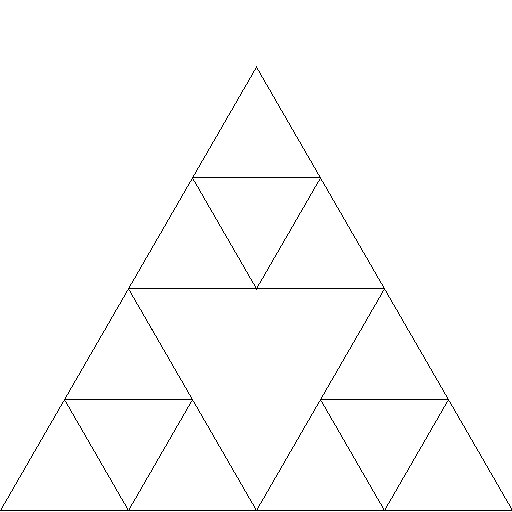





- Towers of Hanoi variant. Consider the following variant of the towers of Hanoi problem. There are 2N discs of increasing size stored on three poles. Initially all of the discs with odd size (1, 3, ..., 2N-1) are piled on the left pole from top to bottom in increasing order of size; all of the discs with even size (2, 4, ..., 2N) are piled on the right pole. Write a program to provide instructions for moving the odd discs to the right pole and the even discs to the left pole, obeying the same rules as for towers of Hanoi.
- Animated towers of Hanoi animation. Use StdDraw to animate a solution to the towers of Hanoi problem, moving the discs at a rate of approximately 1 per second.
- Binomial distribution. Estimate the number of recursive calls that would be used by the code
to compute binomial(100, 50). Develop a better implementation that is based on memoization. Hint: See Exercise 1.4.26.public static double binomial(int N, int k) { if ((N == 0) || (k <> - Collatz function. Consider the following recursive function in Collatz.java, which is related to a famous unsolved problem in number theory, known as the Collatz problem or the 3n + 1 problem.
public static void collatz(int n) { StdOut.print(n + " "); if (n == 1) return; if (n % 2 == 0) collatz(n / 2); else collatz(3*n + 1); }For example, a call to collatz(7) prints the sequence
7 22 11 34 17 52 26 13 40 20 10 5 16 8 4 2 1
as a consequence of 17 recursive calls. Write a program that takes a command-line argument N and returns the value of n <> - Integer set partition. Use memoization to develop a program that solves the set partition problem for positive integer values. You may use an array whose size is the sum of the input values.
- Brownian island. Benoit Mandelbrot asked the famous question How long is the coast of Britain? Modify Brownian.java to get a programBrownianIsland.java that plots Brownian islands, whose coastlines resemble that of Great Britain. The modifications are simple: first, changecurve() to add a gaussian to the x coordinate as well as to the y coordinate; second, change main() to draw a curve from the point at the center of the canvas back to itself. Experiment with various values of the arguments to get your program to produce islands with a realistic look.
- Voting power. John F. Banzhaf III proposed a ranking system for each coalition in a block voting system. Suppose party i control w[i] votes. A strict majority of the votes is needed to accept or reject a proposal. The voting power of party i is the number of minority coalitions it can join and turn it into a winning majority coalition. Write a program VotingPower.java that takes in a list of coalition weights as command-line argument and prints out the voting power of each coalition. Hint: use Schedule.java as a starting point.
- A strange function. Consider McCarthy's 91 function:
public static int mcCarthy(int n) { if (n > 100) return n - 10; else return mcCarthy(mcCarthy(n+11)); }Determine the value of mcCarthy(50) without using a computer. Give the number of recursive calls used by mcCarthy() to compute this result. Prove that the base case is reached for all positive integers n or give a value of n for which this function goes into a recursive loop.
Web Exercises
- Does Euclid.java still work if the inputs can be negative? If not, fix it. Hint: Recall that % can return a negative integer if the first input is negative. When calling the function, take the absolute value of both inputs.
- Write a recursive program GoldenRatio.java that takes an integer input N and computes an approximation to the golden ratio using the following recursive formula:
Redo, but do not use recursion.f(N) = 1 if N = 0 = 1 + 1 / f(N-1) if N > 0
- Discover a connection between the golden ratio and Fibonacci numbers. Hint: consider the ratio of successive Fibonacci numbers: 2/1, 3/2, 8/5, 13/8, 21/13, 34/21, 55/34, 89/55, 144/89, ...
- Consider the following recursive function. What is mystery(1, 7)?
public static int mystery(int a, int b) { if (0 == b) return 0; else return a + f(a, b-1); }Will the function in the previous exercise terminate for every pair of integers a and b between between 0 and 100? Give a high level description of what mystery(a, b) returns, given integers a and b between 0 and 100.
Answer: mystery(1, 7) = 1 + mystery(1, 6) = 1 + (1 + mystery(1, 5)) = ... 7 + mystery(1, 0) = 7.
Answer: Yes, the base case is b = 0. Successive recursive calls reduce b by 1, driving it toward the base case. The function mystery(a, b)returns a * b. Mathematically inclined students can prove this fact via induction using the identity ab = a + a(b-1).
- Consider the following function. What does mystery(0, 8) do?
Answer: infinite loop.public static void mystery(int a, int b) { if (a != b) { int m = (a + b) / 2; mystery(a, m); StdOut.println(m); mystery(m, b); } } - Consider the following function. What does mystery(0, 8) do?
Answer: stack overflow.public static void mystery(int a, int b) { if (a != b) { int m = (a + b) / 2; mystery(a, m - 1); StdOut.println(m); mystery(m + 1, b); } } - Repeat the previous exercise, but replace if (a != b) with if (a <= b).
- What does mystery(0, 8) do?
public static int mystery(int a, int b) { if (a == b) StdOut.println(a); else { int m1 = (a + b ) / 2; int m2 = (a + b + 1) / 2; mystery(a, m1); mystery(m2, b); } } - What does the following function compute?
public static int f(int n) { if (n == 0) return 0; if (n == 1) return 1; if (n == 2) return 1; return 2*f(n-2) + f(n-3); - Write a program Fibonacci2.java that takes a command-line argument N and prints out the first N Fibonacci numbers using the following alternate definition:
F(n) = 1 if n = 1 or n = 2 = F((n+1)/2)2 + F((n-1)/2)2 if n is odd = F(n/2 + 1)2 - F(n/2 - 1)2 if n is even
What is the biggest Fibonacci number you can compute in under a minute using this definition? Compare this to Fibonacci.java.
- Write a program that takes a command-line argument N and prints out the first N Fibonacci numbers using the following method proposed by Dijkstra:
F(0) = 0 F(1) = 1 F(2n-1) = F(n-1)^2 + F(n)^2 F(2n) = (2F(n-1) + F(n)) * F(n)
- Prove by mathematical induction that the alternate definitions of the Fibonacci function given in the previous two exercises are equivalent to the original definition.
- Write a program Pell.java that takes a command-line argument N and prints out the first N Pell numbers: p0 = 0, p1 = 1, and for n >= 2, pn = 2 pn-1 + pn-2. Print out the ratio of successive terms and compare to 1 + sqrt(2).
- Consider the following function from program Recursion.java:
public static void mystery(int n) { if (n == 0 || n == 1) return; mystery(n-2); StdOut.println(n); mystery(n-1); }What does mystery(6) print out? Hint: first figure out what mystery(2), mystery(3), and so forth print out.
- What would happen in the previous exercise if the base case was replaced with the following statement?
if (n == 0) return;
- Consider the following recursive functions.
public static int square(int n) { if (n == 0) return 0; return square(n-1) + 2*n - 1; } public static int cube(int n) { if (n == 0) return 0; return cube(n-1) + 3*(square(n)) - 3*n + 1; }What is square(5)? cube(5)? cube(123)?
- Consider the following pair of mutually recursive functions. What does g(g(2)) evaluate to?
public static int f(int n) { public static int g(int n) { if (n == 0) return 0; if (n == 0) return 0; return f(n-1) + g(n-1); return g(n-1) + f(n); } } - Write program to verify that (for small values of n) the sum of the cubes of the first n Fibonacci numbers F(0)^3 + F(1)^3 + ... + F(n)^3 equals (F(3n+4) + (-1)^n * 6 * f(n-1)) / 10, where F(0) = 1, F(1) = 1, F(2) = 2, and so forth.
- Transformations by increment and unfolding. Given two integers a ≤ b, write a program Sequence.java that transforms a into b by a minimum sequence of increment (add 1) and unfolding (multiply by 2) operations. For example,
% java Sequence 5 23 23 = ((5 * 2 + 1) * 2 + 1) % java Sequence 11 113 113 = ((((11 + 1) + 1) + 1) * 2 * 2 * 2 + 1)
- Hadamard matrix. Write a recursive program Hadamard.java that takes a command-line argument n and plots an N-by-N Hadamard pattern where N = 2n. Do not use an array. A 1-by-1 Hadamard pattern is a single black square. In general a 2N-by-2N Hadamard pattern is obtained by aligning 4 copies of the N-by-N pattern in the form of a 2-by-2 grid, and then inverting the colors of all the squares in the lower right N-by-N copy. The N-by-N Hadamard H(N) matrix is a boolean matrix with the remarkable property that any two rows differ in exactly N/2 bits. This property makes it useful for designing error-correcting codes. Here are the first few Hadamard matrices.




- 8 queens problem. In this exercise, you will solve the classic 8-queens problem: place 8 queens on an 8x8 chess board so that no two queens are in the same row, column, or diagonal. There are 8! = 40,320 ways in which no two queens are placed in the same row or column. Any permutation p[] of the integers 0 to 7 gives such a placement: put queen i in row i, column p[i]. Your program Queens.java should take one command-line argument N and enumerate all solutions to the N-queens problem by drawing the location of the queens in ASCII like the two solutions below.
Hint: to determine whether setting q[n] = i conflicts with q[0] through q[n-1]* * * Q * * * * * * * * Q * * * * Q * * * * * * * Q * * * * * * * * * * * * Q * * * * Q * * * * * * Q * * * * * * * * * * * Q * * * * * * Q * * * * Q * * * * * * * * * * * * Q * * * * * * * Q * * * * Q * * * * * * * * Q * * Q * * * * * * * Q * * * * * * *
- if q[i] equals q[n]: two queens are placed in the same column
- if q[i] - q[n] equals n - i: two queens are on same major diagonal
- if q[n] - q[i] equals n - i: two queens are on same minor diagonal
- Another 8 queens solver. Program Queens2.java solves the 8 queens problem by implicitly enumeration all N! permutations (instead of the N^N placements). It is based on program Permutations.java.
- Euclid's algorithm and π. The probability that two numbers chosen from a large random set of numbers have no common factors (other than 1) is 6 / π2. Use this idea to estimate π. Robert Matthews use the same idea to estimate π by taken the set of numbers to be a function of the positions of stars in the sky.
- Towers of Hanoi variant II. (Knuth-Graham and Pathashnik) Solve the original Towers of Hanoi problem, but with the extra restriction that you are not allowed to directly transfer a disk from A to C. How many moves does it take to solve a problem with N disks? Hint: move N-1 smallest disks from A to C recursively (without any direct A to C moves), move disk N from A to B, move N-1 smallest disks from C to A (without any direct A to C moves), move disk N from B to C, and move N-1 smallest disks from A to C recursively (without any direct A to C moves).
- Towers of Hanoi variant III. Repeat the previous question but disallow both A to C and C to A moves. That is, each move must involve pole B.
- Towers of Hanoi with 4 pegs. Suppose that you have a fourth peg. What is the least number of moves needed to transfer a stack of 8 disks from the leftmost peg to the rightmost peg? Answer. Finding the shortest such solution in general has remained an open problem for over a hundred years and is known as Reve's puzzle.
- Another tricky recursive function. Consider the following recursive function. What is f(0)?
public static int f(int x) { if (x > 1000) return x - 4; else return f(f(x+5)); } - Checking if N is a Fibonacci number. Write a function to check if N is a Fibonacci number. Hint: a positive integer is a Fibonacci number if and only if either (5*N*N + 4) or (5*N*N - 4) is a perfect square.
- Random infix expression generator. Run Expr.java with different command-line argument p between 0 and 1. What do you observe?
public static String expr(double p) { double r = Math.random(); if (r <= 1*p) return "(" + expr(p) + " + " + expr(p) + ")"; if (r <= 2*p) return "(" + expr(p) + " * " + expr(p) + ")"; return "" + (int) (100 * Math.random()); } - A tricky recurrence. Define F(n) so that F(0) = 0 and F(n) = n - F(F(n-1)). What is F(100000000)?
Solution: The answer is related to the Fibonacci sequence and the Zeckendorf representation of a number.
- von Neumann ordinal. The von Neumann integer i is defined as follows: for i = 0, it is the empty set; for i > 0, it is the set containing the von Neumann integers 0 to i-1.
Write a program Ordinal.java with a recursive function vonNeumann() that takes a nonnegative integer N and returns a string representation of the von Neumann integer N. This is a method for defining ordinals in set theory.0 = {} = {} 1 = {0} = {{}} 2 = {0, 1} = {{}, {{}}} 3 = {0, 1, 2} = {{}, {{}}, {{}, {{}}}} - Subsequences of a string. Write a program Subsequence.java that takes a string command-line argument s and an integer command-line argument k and prints out all subsequences of s of length k.
% java Subsequence abcd 3 abc abd acd bcd
- Interleaving two strings. Given two strings s and t of distinct characters, print out all (M+N)! / (M! N!) interleavings, where M and N are the number of characters in the two strings. For example, if
s = "ab" t = "CD" abCD CabD aCbD CaDb aCDb CDab
- Binary GCD. Write a program BinaryGCD.java that finds the greatest common divisor of two positive integers using the binary gcd algorithm: gcd(p, q) =
- p if q = 0
- q if p = 0
- 2 * gcd(p/2, q/2) if p and q are even
- gcd(p/2, q) if p is even and q is odd
- gcd(p, q/2) if p is odd and q is even
- gcd((p-q)/2, q) if p and q are odd and p >= q
- gcd(p, (q-p)/2) if p and q are odd and p <>
- Integer partitions. Write a program Partition.java that takes a positive integer N as a command-line argument and prints out all partitions of N. A partition of N is a way to write N as a sum of positive integers. Two sums are considered the same if they only differ in the order of their constituent summands. Partitions arise in symmetric polynomials and group representation theory in mathematics and physics.
% java Partition 4 % java Partition 6 4 6 3 1 5 1 2 2 4 2 2 1 1 4 1 1 1 1 1 1 3 3 3 2 1 3 1 1 1 2 2 2 2 2 1 1 2 1 1 1 1 1 1 1 1 1 1
- Johnson-Trotter permutations. Write a program JohnsonTrotter.java that take a command-line argument n and prints out all n! permutations of the integer 0 through n-1 in such a way that consecutive permutations differ in only one adjacent transposition (similar to way Gray code iterates over combinations in such a way that consecutive combinations differ in only one bit).
% java JohnsonTrotter 3 012 (2 1) 021 (1 0) 201 (2 1) 210 (0 1) 120 (1 2) 102 (0 1)
- Permutations in lexicographic order. Write a program PermutationsLex.java that take a command-line argument N and prints out all N! permutations of the integer 0 through N-1 in lexicographic order.
% java PermutationsLex 3 012 021 102 120 201 210
- Derangements. A derangement is a permutation p[] of the integers from 0 to N-1 such that p[i] doesn't equal i for any i. For example there are 9 derangmenets when N = 4: 1032, 1230, 1302, 2031, 2301, 2310, 3012, 3201, 3210. Write a program to count the number of derangements of size N using the following recurrence: d[N] = (N-1) (d[N-1] + d[N-2]), where d[1] = 0, d[2] = 1. The first few terms are 0, 1, 2, 9, 44, 265, 1854, 14833, 133496, and 1334961.
- Tribonacci numbers. The tribonacci numbers are similar to the Fibonacci numbers, except that each term is the sum of the three previous terms in the sequence. The first few terms are 0, 0, 1, 1, 2, 4, 7, 13, 24, 44, 81. Write a program to compute tribonacci numbers. What is the ratio successive terms? Answer. Root of x^3 - x^2 - x - 1, which is approximately 1.83929.
- Sum of first n Fibonacci numbers. Prove by induction that the sum of the first n Fibonacci numbers F(1) + F(2) + ... + F(N) is F(N+2) - 1.
- Gray codes. An order n Gray code is an n-bit encoding of the integers 0 to 2n - 1 such that adjacent numbers differ in only one bit. The following is a 3-bit Gray code.
000 001 011 010 110 111 101 100 0 1 3 2 6 7 5 4
Gray codes have many applications. For example, they can be used to increase the reliability of counting of analog-to-digital converters. Counting by Gray code reduces the chance of such errors since only one bit of the counter changes in each step. Gray codes have also been used in pulse code communication, the minimization of logic circuits, hypercube architectures, and were even proposed to organize books on library shelves.
Write a program GrayCode.java that reads in a command-line argument N and prints out the order N binary reflected Gray code.
- Gray codes II. Redo the previous exercise but do not use Java's built in string class. Instead, do it with a boolean array and name your programGrayCodeArray.java.
- Combinational Gray Code. Print out all combination of k of n items in such a way that consecutive combinations differ in exactly one element, e.g., if k = 3 and n = 5, 123, 134, 234, 124, 145, 245, 345, 135, 235, 125. Hint: use the Gray code, but only print out those integers with exactly k 1's in their binary representation.
- Maze generation. Create a maze using divide-and-conquer: Begin with a rectangular region with no walls. Choose a random gridpoint in the rectangle and construct two perpendicular walls, dividing the square into 4 subregions. Choose 3 of the four regions at random and open a one cell hole at a random point in each of the 3. Recur until each subregion has width or height 1.
Plasma cloud.
Extending the midpoint displacement method to two dimensions produces fractals known as plasma clouds. To draw a square plasma cloud, we use a recursive plan where the base case is to draw a square of a given color and the reduction step is to draw a plasma cloud in each quadrant with colors that are perturbed from the average with a random Gaussian. Using the same volatility and smoothness controls as in Brownian, we can produce synthetic clouds that are remarkably realistic. We can use the same code to produce synthetic terrain, by interpreting the color value as the altitude. Variants of this scheme are widely used in the entertainment industry to generate artificial background scenery for movies and the "Genesis effect" in Star Trek II and the "outline of the "Death Star" in Return of the Jedi. - Plasma clouds. Program PlasmaCloud.java takes a command-line argument N and produces a random N-by-N plasma fractal using the midpoint displacement method.
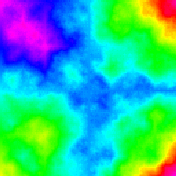
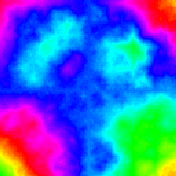
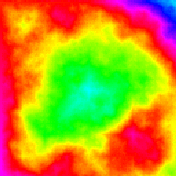
Here's an 800-by-800 example. Here's a reference, including a simple 1D version. Note: some visual artifacts are noticeable parallel to the x and y axes. Doesn't have all of the statistical properties of 2D fractional Brownian motion.
- Fern fractal. Write a recursive program to draw a fern or tree, as in this fern fractal demo.

